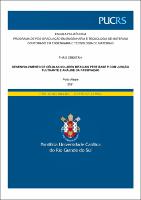| Share record |


|
Please use this identifier to cite or link to this item:
https://tede2.pucrs.br/tede2/handle/tede/9872| Document type: | Tese |
| Title: | Desenvolvimento de células solares bifaciais PERT base P com junção flutuante e análise da passivação |
| Author: | Crestani, Thais  |
| Advisor: | Zanesco, Izete |
| First advisor-co: | Moehlecke, Adriano |
| Abstract (native): | A célula solar bifacial converte a energia solar incidente em ambas as faces em energia elétrica. A expectativa é que nos próximos anos a tecnologia de módulos bifaciais seja mais utilizada do que a de módulos monofaciais. O objetivo deste trabalho foi desenvolver células solares bifaciais PERT, base p, com redução de etapas térmicas. No processo α, utilizou-se a patente concedida BR 10 2012 030606-9 B1 e reduziram-se duas etapas térmicas na difusão dos dopantes. No processo β, solicitação de patente BR 10 2018 0085760, reduziram-se três etapas térmicas em relação ao processo convencional e a difusão de boro e fósforo foi realizada na mesma etapa térmica. Otimizou-se o emissor, o campo retrodifusor (BSF) e o processo de queima das pastas metálicas. Também se analisou o tempo de vida dos portadores de carga minoritários e a passivação com SiO2 e desenvolveram-se métodos para formar a junção flutuante no BSF e no emissor. Os maiores parâmetros elétricos das células solares produzidas com os processos α e β foram obtidos com a mesma temperatura e tempo tanto para formar o emissor quanto o BSF. Verificou-se que o tempo de vida dos portadores de carga minoritários final é maior que o inicial e os melhores resultados foram encontrados com o processo β. A maior eficiência () foi obtida com passivação com SiO2 e a junção flutuante não aumentou os parâmetros elétricos. No processo α, as maiores eficiências foram obtidas com a temperatura de oxidação (TOXI) de 800 °C e 830 °C, com tempo de 45 e 30 minutos, respectivamente. Com a TOXI de 800 C foi obtida a maior ηemissor, de 16,9 %. No entanto, o maior valor da tensão de circuito aberto, de 605,9 mV, foi obtido com a TOXI de 830 °C. Com o processo β, os maiores valores dos parâmetros elétricos foram obtidos com a TOXI de 800 °C e tempo de 45 minutos, resultando na ηemissor de 16,6 % e ηBSF de 12,7 %. A eficiência obtida é um pouco menor da eficiência de um módulo bifacial comercial (ηemissor = 20,5 % e ηBSF = 14,4 %), porém o processo de produção possui menos etapas e, consequentemente, há redução de custo de produção. |
| Abstract (english): | The bifacial solar cell converts the solar energy incident on both sides into electrical energy. The expectation is that in the coming years the technology of bifacial modules will be used more than that of monofacial modules. The objective of this work was to develop PERT p-type bifacial solar cells, with reduction of thermal steps. In process α, the patent granted BR 10 2012 030606-9 B1 was used and two thermal steps in the diffusion of dopants were reduced. In the process β, patent application BR 10 2018 0085760, three thermal steps were reduced in relation to the standard process and the diffusion of boron and phosphorus was carried out in the same thermal step. The emitter, the back surface field (BSF) and the firing process of the metallization pastes were optimized. The minority charge carrier lifetime and the SiO2 passivation were also analyzed and methods to form the floating junction in the BSF and in the emitter were developed. The higher electrical parameters of solar cells produced with the process α and β were obtained with the same temperature and time to form both the emitter and the BSF. The minority charge carrier lifetime after thermal steps is higher than the initial one and better results were obtained with the process β. The higher efficiency () was obtained with SiO2 passivation and the floating junction did not improve the electrical parameters. In the process α, the higher efficiency was obtained with the oxidation temperature (TOXI) of 800 °C and 830 °C and time of 45 and 30 minutes, respectively. With the TOXI of 800 °C the efficiency of 16.9 % was obtained with irradiance in the emitter. However, high open circuit voltage value of 605.9 mV was obtained with the TOXI of 830 °C. With the process β, the higher values of the electrical parameters were obtained with a TOXI of 800 °C and time of 45 minutes, resulting in a ηemitter of 16.6 % and ηBSF of 12.7 %. The efficiency obtained is a little lower than the efficiency of a commercial bifacial module (ηemitter = 20.5 % and ηBSF = 14.4%), but the production process has fewer steps and, consequently, there is a reduction in production cost. |
| Keywords: | Células Solares Bifaciais PERT Otimização do Emissor e do Campo Retrodifusor Passivação Junção Flutuante PERT Bifacial Solar Cells Emitter and Back Surface Field Optimization Passivation Floating Junction |
| CNPQ Knowledge Areas: | ENGENHARIAS |
| Language: | por |
| Country: | Brasil |
| Publisher: | Pontifícia Universidade Católica do Rio Grande do Sul |
| Institution Acronym: | PUCRS |
| Department: | Escola Politécnica |
| Program: | Programa de Pós-Graduação em Engenharia e Tecnologia de Materiais |
| Access type: | Acesso Aberto |
| Fulltext access restriction: | Trabalho não apresenta restrição para publicação |
| URI: | http://tede2.pucrs.br/tede2/handle/tede/9872 |
| Issue Date: | 10-Aug-2021 |
| Appears in Collections: | Programa de Pós-Graduação em Engenharia e Tecnologia de Materiais |
Files in This Item:
| File | Description | Size | Format | |
|---|---|---|---|---|
| Tese Thais Crestani.pdf | THAIS_CRESTANI_TES | 4.59 MB | Adobe PDF |  Download/Open Preview |
Items in DSpace are protected by copyright, with all rights reserved, unless otherwise indicated.




